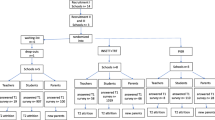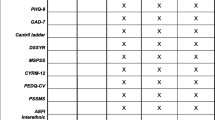Abstract
The current study presents the implementation of a set of school based interventions in a greater New Orleans school district one year following Hurricane Katrina. The interventions included adaptation and implementation of evidence based treatments in a crisis situation with at-risk youth which involved training and clinical challenges. 386 students found to have significant depressive and/or disruptive disorder symptoms received treatment from the School Therapeutic Enhancement Program (STEP). Further, a district-wide mental health needs assessment of middle and high school students (N = 11,861) screened for behavioral and emotional difficulties at the beginning and end of the school year provided a benchmark for community youth’s emotional and behavioral distress. High-need intervention students demonstrated clinically significant lower levels of emotional and behavioral problems, depression and inattention in comparison to pre-treatment levels as indicated by multiple informants (i.e., self, parent, teacher). Self-reported distress levels were also lower than screening group students at post-test. These findings support the efficacy of a school-based intervention for youth struggling with the aftereffects of a highly disruptive natural disaster. Implications for utilizing a flexible adaptation of an evidence-based training model involving coaching and consultation are discussed.

Similar content being viewed by others
References
Abramson, D. M., Morse, S. S., Garrett, A. L., & Redlener, I. (2007). Public health disaster research: surveying the field, defining its future. Disaster Medicine and Public Health Preparedness, 1(1), 57–62. doi:10.1097/DMP.0b013e318065b7e1.
Abramson, D. M., Park, Y. S., Stehling-Ariza, T., & Redlener, I. (2010). Children as bellwethers of recovery: dysfunctional systems and the effects of parents, households, and neighborhoods on serious emotional disturbance in children after Hurricane Katrina. Disaster Med Public Health Preparedness, 4(Suppl 1), S17–S27. doi:10.1001/dmp.2010.7.
Beck, J. S., Beck, A. T., Jolly, J. B., & Steer, R. A. (2005). Beck youth inventory-II manual. San Antonio: Harcourt Assessment Inc.
Beidas, R. S., & Kendall, P. C. (2010). Training therapists in evidence-based practice: A critical review of studies from a systems-contextual perspective. Clinical Psychology (New York), 17(1), 1–30. doi:10.1111/j.1468-2850.2009.01187.x.
Bourdon, K. H., Goodman, R., Rae, D. S., Simpson, G., & Koretz, D. S. (2005). The Strengths and Difficulties Questionnaire: US normative data and psychometric properties. Journal of the American Academy of Child and Adolescent Psychiatry, 44(6), 557–564. doi:10.1097/01.chi.0000159157.57075.c8.
Bussing, R., Fernandez, M., Harwood, M., Hou, W., Garvan, C. W., Eyberg, S. M., et al. (2008). Parent and teacher SNAP-IV ratings of attention deficit hyperactivity disorder symptoms: psychometric properties and normative ratings from a school district sample. Assessment, 15(3), 317–328.
Chorpita, B. F., Daleiden, E. L., & Weisz, J. R. (2005). Identifying and selecting the common elements of evidence based interventions: a distillation and matching model. Mental Health Services Research, 7(1), 5–20.
Cohen, J. A., Jaycox, L. H., Walker, D. W., Mannarino, A. P., Langley, A. K., & DuClos, J. L. (2009). Treating traumatized children after Hurricane Katrina: Project Fleur-de lis. Clinical Child and Family Psychology Review, 12(1), 55–64. doi:10.1007/s10567-009-0039-2.
Dean, K. L., Langley, A. K., Kataoka, S. H., Jaycox, L. H., Wong, M., & Stein, B. D. (2008). School-based disaster mental health services: Clinical, policy, and community challenges. Professional Psychology, 39(1), 52–57.
Edmunds, J. M., Beidas, R. S., & Kendall, P. C. (2013). Dissemination and Implementation of Evidence-Based Practices: training and Consultation as Implementation Strategies. Clin Psychol (New York), 20(2), 152–165. doi:10.1111/cpsp.12031.
Goodman, R. (1997). The Strengths and Difficulties Questionnaire: A research note. Journal of Child Psychology and Psychiatry, 38(5), 581–586.
Goodman, R., Meltzer, H., & Bailey, V. (1998). The Strengths and Difficulties Questionnaire: A pilot study on the validity of the self-report version. European Child and Adolescent Psychiatry, 7(3), 125–130.
Hedeker, D., & Gibbons, R. D. (2006). Longitudinal data analysis. Hoboken: Wiley.
Hedeker, D., Gibbons, R., Du Toit, M., & Chong, Y. (2008). Supermix mixed effects models. Lincolnwood: Scientific Software International.
Jaycox, L. H., Cohen, J. A., Mannarino, A. P., Walker, D. W., Langley, A. K., Gegenheimer, K., et al. (2010). Children’s mental health care following Hurricane Katrina: A field trial of trauma-focused psychotherapies. Journal of Traumatic Stress, 23(2), 223–231.
Jaycox, L. H., Morse, L. K., Tanielian, T., & Stein, B. D. (2006). How schools can help students recover from traumatic experiences. Santa Monica: Rand Corporation.
Jaycox, L. H., Tanielian, T. L., Sharma, P., Morse, L., Clum, G., & Stein, B. D. (2007). Schools’ mental health responses after Hurricanes Katrina and Rita. Psychiatric Services (Washington, DC), 58(10), 1339–1343. doi:10.1176/appi.ps.58.10.1339.
Jones, R. T., Burns, K. D., Immel, C. S., Moore, R. M., Schwartz-Goel, K., & Culpepper, B. (2009). The impact of Hurricane Katrina on children and adolescents: Conceptual and methodological implications for assessment and intervention. In Lifespan perspectives on natural disasters: Coping with Katrina, Rita, and other storms (pp. 65–94). New York, NY: Springer.
Juszczak, L., Melinkovich, P., & Kaplan, D. (2003). Use of health and mental health services by adolescents across multiple delivery sites. Journal of Adolescent Health, 32(6 Suppl), 108–118.
Kilmer, R. P., Gil-Rivas, V., & MacDonald, J. (2010). Implications of major disaster for educators, administrators, and school-based mental health professionals: Needs, actions, and the example of Mayfair Elementary. In Helping families and communities recover from disaster: Lessons learned from hurricane Katrina and its aftermath (pp. 167–191). Washington, DC: American Psychological Association; US.
Laird, N. M. (1988). Missing data in longitudinal studies. Statistics in Medicine, 7(1–2), 305–315.
Lochman, J. E., Wells, K. C., & Lenhart, L. A. (2008). Coping power: Child group program workbook. New York: Oxford University Press.
Lyon, A. R., Lau, A. S., McCauley, E., Vander Stoep, A., & Chorpita, B. F. (2014). A case for modular design: Implications for implementing evidence-based interventions with culturally diverse youth. Professional Psychology, 45(1), 57–66.
Madrid, P. A., Garfield, R., Jaberi, P., Daly, M., Richard, G., & Grant, R. (2008a). Mental health services in Louisiana school-based health centers post-Hurricanes Katrina and Rita. Professional Psychology, 39(1), 45–51.
Madrid, P. A., Sinclair, H., Bankston, A. Q., Overholt, S., Brito, A., Domnitz, R., et al. (2008b). Building integrated mental health and medical programs for vulnerable populations post-disaster: connecting children and families to a medical home. Prehospital and Disaster Medicine, 23(4), 314–321.
McLaughlin, K. A., Fairbank, J. A., Gruber, M. J., Jones, R. T., Lakoma, M. D., Pfefferbaum, B., et al. (2009). Serious emotional disturbance among youths exposed to Hurricane Katrina 2 years postdisaster. Journal of the American Academy of Child and Adolescent Psychiatry, 48(11), 1069–1078. doi:10.1097/CHI.0b013e3181b76697.
McLaughlin, K. A., Fairbank, J. A., Gruber, M. J., Jones, R. T., Osofsky, J. D., Pfefferbaum, B., Kessler, R. C. (2010). Trends in serious emotional disturbance among youths exposed to Hurricane Katrina. Journal of the American Academy of Child Adolescent Psychiatry, 49(10), 990–1000, 1000 e1001–1002. doi:10.1016/j.jaac.2010.06.012.
Nadeem, E., Gleacher, A., & Beidas, R. S. (2013a). Consultation as an implementation strategy for evidence-based practices across multiple contexts: Unpacking the black box. Administration and Policy In Mental Health,. doi:10.1007/s10488-013-0502-8.
Nadeem, E., Gleacher, A., Pimentel, S., Hill, L. C., McHugh, M., & Hoagwood, K. E. (2013b). The role of consultation calls for clinic supervisors in supporting large-scale dissemination of evidence-based treatments for children. Administration and Policy In Mental Health,. doi:10.1007/s10488-013-0491-7.
Nastasi, B. K., Overstreet, S., & Summerville, M. (2011). School-based mental health services in post-disaster contexts: A public health framework. School Psychology International, 32(5), 533–552.
Pullmann, L. D., Johnson, P. L., & Faran, M. E. (2014). Implementing an evidence-based practices training curriculum to US Army child and family behavioral health providers. Journal of Clinical Child and Adolescent Psychology, 43(2), 158–168.
Rones, M., & Hoagwood, K. (2000). School-based mental health services: A research review. Clinical Child and Family Psychology Review, 3(4), 223–241.
Stapleton, L. M., Sander, J. B., & Stark, K. D. (2007). Psychometric properties of the Beck Depression Inventory for Youth in a sample of girls. Psychological Assessment, 19(2), 230–235. doi:10.1037/1040-3590.19.2.230.
Stark, K. D., Curry, J., Goldman, E., & Consortium, I. P. (2004). The Integrated Psychotherapy Consortium: Depressive Symptoms Intervention Manual (P. Jensen, E. Goldman, J. M. Levitt & E. Pease Eds.). New York: New York State Office of Mental Health.
Stark, K. D., Streusand, W., Arora, P., & Patel, P. (2012). Childhood depression: The ACTION treatment program Child and adolescent therapy: Cognitive-behavioral procedures (4th ed., pp. 190–233). New York: Guilford Press.
Stone, L. L., Otten, R., Engels, R. C., Vermulst, A. A., & Janssens, J. M. (2010). Psychometric properties of the parent and teacher versions of the Strengths and Difficulties Questionnaire for 4- to 12-year-olds: A review. Clinical Child and Family Psychology Review, 13(3), 254–274.
Swanson, J., Lerner, M., March, J., & Gresham, F. M. (1999). Assessment and intervention for attention-deficit/hyperactivity disorder in the schools. Lessons from the MTA study. Pediatric Clinics of North America, 46(5), 993–1009.
Vandivere, S., O’Hare, W. P., Atienza, A., & Rivers, K. L. (2007). States ranked on the basis of child well-being for children in low-income families. Washington: Annie E. Casey Foundation.
Weems, C. F., Taylor, L. K., Cannon, M. F., Marino, R. C., Romano, D. M., Scott, B., et al. (2010). Post traumatic stress, context, and the lingering effects of the Hurricane Katrina disaster among ethnic minority youth. Journal of Abnormal Child Psychology, 38(1), 49–56. doi:10.1007/s10802-009-9352-y.
Wells, K., Lochman, J., Goldman, E., & Consortium, I. P. (2004). The Integrated Psychotherapy Consortium: Disruptive Symptoms Intervention Manual (P. Jensen, E. Goldman, J. M. Levitt & E. Pease Eds.). New York: New York State Office of Mental Health.
Wilson, S. J., Lipsey, M. W., & Derzon, J. H. (2003). The effects of school-based intervention programs on aggressive behavior: A meta-analysis. Journal of Consulting and Clinical Psychology, 71(1), 136–149.
Funding
For the School Therapeutic Enhancement Program (STEP) was made possible by a Social Services Block Grant G-0601LASOSR, 2006 through the Administration for Children and Families, Department of Health and Human Services. The authors of this article thank the JPHSA social workers who implemented this treatment program, Angela Henry, MSW, Children’s Services Director, JPHSA and the children and families of Jefferson Parish. In addition, we thank Erum Nadeem, Ph.D, NYU Langone Medical Center for her help in the preparation of this manuscript.
Author information
Authors and Affiliations
Consortia
Corresponding author
Additional information
The members of the Integrated Psychotheraphy Consortium are listed in the appendix section.
Appendix
Appendix
The Integrated Psychotherapy Consortium (IPC) is a group of clinician-researchers who initially trained New York City therapists in evidence-based therapies (EBTs) after September 11, 2001 using interventions they had each independently developed (i.e., cognitive behavioral therapies for depression, disruptive disorders, anxiety disorders, and PTSD). The IPC clinician-researchers work to integrate and align their different teaching approaches and CBT manuals into a more common approach to allow practicing therapists to rapidly learn and acquire the essential skills for each of the EBTs. Continued support for disseminating their integrated therapies and training approaches is handled through the REACH Institute, an evidence-based practices dissemination organization. Information about the intervention manuals described in this manuscript can be obtained at www.thereachinstitute.org. The IPC includes Peter S. Jensen, M.D., the REACH Institute, Bruce Chorpita, Ph.D. Christopher M. Layne, Ph.D. and William R. Saltzman, Ph.D., UCLA, John Curry, Ph.D. and Karen C. Wells, Ph.D., Duke University School of Medicine, Eliot E. Goldman, Ph.D., Columbia University College of Physicians and Surgeons, John E. Lochman, Ph.D., University of Alabama, Kevin Stark, University of Texas-Austin, Thomas H. Ollendick, Ph.D., Virginia Tech University, Ron Rapee, Ph.D., Macquarie University, Wendy K. Silverman, Ph.D., Yale University School of Medicine.
Rights and permissions
About this article
Cite this article
Goldman, E.E., Bauer, D., Newman, D.L. et al. A School-Based Post-Katrina Therapeutic Intervention. Adm Policy Ment Health 42, 363–372 (2015). https://doi.org/10.1007/s10488-014-0576-y
Published:
Issue Date:
DOI: https://doi.org/10.1007/s10488-014-0576-y




